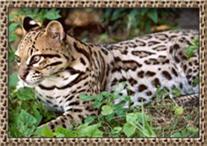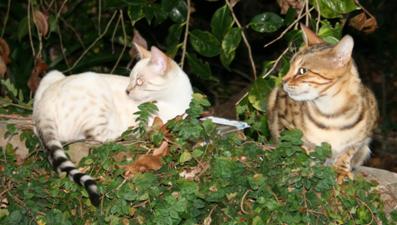 In the Beginning In the Beginning
The Bengal breed of cat began by the mating of an Asian Leopard Cat (ALC) to a domestic feline. The ALC's habitat extends throughout the colder regions ofAsia such as Siberia & the mountainous Himalayas, as well as the more temperate zones such as the South-East Asian peninsula & Indonesia .
 Originally the mating of an ALC with a domestic to create a hybrid was done as part of a scientific research programme in the hope of finding a cure for leukaemia both in other cats & hopefully, humans, as the ALC exhibited immunity. The first three generations are called filial, with an F-1 being half ALC.Male. Those super sized American Bengals you see are usually F-1s. F-1’s through F-3’s are generally sterile so only female filials can be used for breeding. NZ is not allowed to import any generations before an F4. Which what is considered a Bengal cats (as 4th generation from the ALC & beyond are known) but feed your baby up as a kitten to help it reach max size potential. Originally the mating of an ALC with a domestic to create a hybrid was done as part of a scientific research programme in the hope of finding a cure for leukaemia both in other cats & hopefully, humans, as the ALC exhibited immunity. The first three generations are called filial, with an F-1 being half ALC.Male. Those super sized American Bengals you see are usually F-1s. F-1’s through F-3’s are generally sterile so only female filials can be used for breeding. NZ is not allowed to import any generations before an F4. Which what is considered a Bengal cats (as 4th generation from the ALC & beyond are known) but feed your baby up as a kitten to help it reach max size potential.
Bengals Today
 
Bengals coat lies close to its body and requires little grooming
Today's Bengal is a delightfully active, intelligent, and affectionate they make wonderful pets that will enrich your life with affection and entertainment. They love to play, climb, run, chase, fetch and get into all sorts of mischief. They love following you around outdoors and are very sociable so I never recommend you have one on its own especially if you are working, they thrive on companionship and attention whether it be their human family or other cats and pets. They love to be in the middle of whatever is going on and much prefer to play fetch with their favourite toy, wrestle with a companion or chase imaginary prey than to sit lazily in a lap, that is during the day by night time a lap in front of the TV become prime target and you better not get up to often because that will really not be acceptable. Some Bengals enjoy playing in water and others can learn to walk on a harness and leash. |

Where do the different colours come from?
Various Asian Leopard Cats (ALCs) were mated with pedigree cats (for example, the Burmese, Siamese to get Snow Lynx’s, Tonkinese to get Snow Minks, Abyssinian, Egyptian Mau) and the American Domestic Shorthair in order to create a breed of cat that retained the breath-taking wild spotting and muscular body of the Asian leopard and yet exhibited the affectionate, loving nature of the domestic. The seal sepia comes from the introduction of the Burmese colouring into the Bengals. Seal sepias exhibit gold to green eye colour and are full colour at birth. Some sepias can be quite hard to distinguish from the brown tabbies. In some cases it is difficult to distinguish the colour of the seal mink and the seal sepia until these cats are bred and produce progeny. The sepia cannot produce a seal lynx. If a seal lynx is produced in a breeding of the cat in question then it is a seal mink.
See colours and patterns page for more detail
To find out more about the Bengal cat visit The International Bengal Cat Society (TIBCS) or The International Bengal Breeders Association (TIBBA) websites.
Find out more about blue Bengals at www.blue-bengals.com |

 In the Beginning
In the Beginning Originally the mating of an ALC with a domestic to create a hybrid was done as part of a scientific research programme in the hope of finding a cure for leukaemia both in other cats & hopefully, humans, as the ALC exhibited immunity. The first three generations are called filial, with an F-1 being half ALC.Male. Those super sized American Bengals you see are usually F-1s. F-1’s through F-3’s are generally sterile so only female filials can be used for breeding. NZ is not allowed to import any generations before an F4. Which what is considered a Bengal cats (as 4th generation from the ALC & beyond are known) but feed your baby up as a kitten to help it reach max size potential.
Originally the mating of an ALC with a domestic to create a hybrid was done as part of a scientific research programme in the hope of finding a cure for leukaemia both in other cats & hopefully, humans, as the ALC exhibited immunity. The first three generations are called filial, with an F-1 being half ALC.Male. Those super sized American Bengals you see are usually F-1s. F-1’s through F-3’s are generally sterile so only female filials can be used for breeding. NZ is not allowed to import any generations before an F4. Which what is considered a Bengal cats (as 4th generation from the ALC & beyond are known) but feed your baby up as a kitten to help it reach max size potential.

